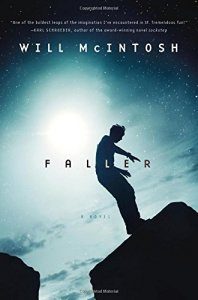Russell Letson reviews Walter Jon Williams
 Walter Jon Williams has a long history of merging elements of the science-fictional/fantastical and thriller/crime genre families, from his Drake Maijstral capers and the dark police-procedural Days of Atonement to the noirish Metropolitan duo. He recently performed this procedure on the day-after-tomorrow techno-thriller in This Is Not a Game (2009), in which alternate-reality-game producer Dagmar Shaw found parts of her invented entertainment environments colliding with the dangerously pointy bits of the real world. As the sequel, Deep State, opens, Dagmar’s Great Big Idea company is promoting the latest James Bond movie with an elaborate Internet-enabled physical-world game featuring a Mystery Tour of events spread across Turkey. For the climactic episodes, her team has installed an extensive temporary infrastructure of video, communications, and physical assets across Istanbul in order to monitor and manipulate the thousands of physically present and online participants as they follow the ‘‘action’’ through the city.This would be one of Great Big Idea’s standard large-scale, high-budget entertainments, were it not for complications arising from a recent coup that has put a junta of prickly, over-controlling military officers in charge of Turkey, the chief of whom Dagmar manages to offend. And to complicate the complications, Dagmar then finds herself with a second, covert client and a second task: the CIA wants her to use Great Big Idea’s resources and techniques to orchestrate a Turkish people-power movement, to astroturf into being a revolution that will oust the military regime.
Walter Jon Williams has a long history of merging elements of the science-fictional/fantastical and thriller/crime genre families, from his Drake Maijstral capers and the dark police-procedural Days of Atonement to the noirish Metropolitan duo. He recently performed this procedure on the day-after-tomorrow techno-thriller in This Is Not a Game (2009), in which alternate-reality-game producer Dagmar Shaw found parts of her invented entertainment environments colliding with the dangerously pointy bits of the real world. As the sequel, Deep State, opens, Dagmar’s Great Big Idea company is promoting the latest James Bond movie with an elaborate Internet-enabled physical-world game featuring a Mystery Tour of events spread across Turkey. For the climactic episodes, her team has installed an extensive temporary infrastructure of video, communications, and physical assets across Istanbul in order to monitor and manipulate the thousands of physically present and online participants as they follow the ‘‘action’’ through the city.This would be one of Great Big Idea’s standard large-scale, high-budget entertainments, were it not for complications arising from a recent coup that has put a junta of prickly, over-controlling military officers in charge of Turkey, the chief of whom Dagmar manages to offend. And to complicate the complications, Dagmar then finds herself with a second, covert client and a second task: the CIA wants her to use Great Big Idea’s resources and techniques to orchestrate a Turkish people-power movement, to astroturf into being a revolution that will oust the military regime.
Dagmar winds up working out of a British airbase on Cyprus with her gaming team augmented by a couple of new computer geeks, some CIA specialists, a rock star’s daughter, a dervish whose sect might have some interesting international connections, and (eventually) the wealth and influence of the Scottish rock star who is the new Bond. Their job will be to somehow unite and organize disenfranchised and dissatisfied factions of Turkish society, to encourage them to overthrow the junta by creating, orchestrating, and above all transmitting events via the latest communications tech:
The revolution would be televised. And tweeted, blogged, attached to emails, YouTubed, Ozoned, googled, edited, remixed, and set to a catchy sound track…. It would be carried on BBC, on CNN, on Star TV, on every other electronic medium dreamed up by an inventive humanity.
But Dagmar, still suffering nightmares and flashbacks from the trauma of her last unwelcome adventure, suspects right from the start that this new project could go wrong. Which it does.
The book’s title is a warning as well as a description. The primary meaning of ‘‘deep state’’ is Turkey’s persistent underlying power structure, which has risen to the surface as the junta. It was organized generations earlier by American cold warriors as a covert defense against Soviet expansion, but now it has evolved into a corrupt military gerontocracy less interested in geopolitics than in the heroin trade. The regime threatens to turn Turkey into ‘‘a narco-terrorist state right on NATO’s flank,’’ so the generals have to go. And since this is an intrigue thriller, there are undercurrents and deceptions and hidden agendas and secret loyalties and unexpected betrayals, deeper states of operation and deeper games being played for higher (or lower) stakes. Dagmar faces not only the normal perils of an elaborate and delicate con, but those of the deep state of international politics, where you don’t know who has been bought or intimidated, who might be a plant, who has a history that will blow up at the worst possible moment.
This is, as events quickly prove, a treacherous and dangerous environment – ‘‘a mire of treachery and mendacity.’’ The generals and their minions are old-fashioned but not completely stupid, and they are quite unembarrassed about responding to people power with violence. And there seem to be leaks somewhere, as the appearance of a team of very specifically informed killers makes clear. Then there’s what seems to be a secret info-war weapon in the hands of the junta, a device able to counter the technologies that support and direct the almost-real revolution. That changes the direction of the action, sending Dagmar out of the office and into the field, where some of her nightmares take on substance.
There is also a deep-state question about the novel’s genre status. A (theoretically) non-SF techno-thriller already offers some of the amusements of hard SF: a focus on how-things-work, on the instrumentalities that provide the thrills; an attention to process and procedure, even unto the catalog-like naming of brands and model numbers of gadgets. Williams’ approach is reflexively hyper-aware, the story of the making of a techno-thriller-like entertainment that itself unfolds like a techno-thriller and then collapses the pretend into the actual – an imaginary adventure with real assassins (and despots and torturers) in it – all viewed with alarm by a character who has already been badly mauled by the collision of the virtual and the real. While the enabling machineries of the story are only mildly science fictional, the thematics are solidly located in the post-modern end of the genre’s conceptual world.
Meanwhile, many of the pleasures of the non-SF thriller are available, particularly those of milieu. Istanbul provides much of pictorial-historical-gustatory-atmospheric texture, along with some quite specific, mappable set-pieces involving civil disturbances and chases-from-the-authorities, but even the workaday anonymity of the Cyprus airbase offices get their share of attention.
The building was… featureless in what Dagmar came to recognize as a military absence of style, efficiency combined with cheapness and an almost fetishistic lack of anything approaching aesthetics… high ceilings with fans and ranked fluorescents, walls thick with decades-old ochre yellow paint and featureless save for pinholes where picture hooks once had been…. Out of some warehouse had come graceless furniture made of metal and painted in unaesthetic colors that only the military employed, as if marking their property by the application of a coat of Ugly.
Dagmar’s crew soon cheers up this drab space with flat-screen monitors, Turkish anti-evil-eye amulets, and a big poster of Mustafa Kemal Atatürk.
And talk about realism: While I was reading Deep State, the wave of popular uprisings swept across North Africa, and I thought back to Greg Egan’s picture of a similar (though uncontrived) technologically enabled people’s revolution in Zendegi (reviewed August 2010), as well as to the very-connected world according to William Gibson in the almost-not-quite-SF Pattern Recognition (reviewed March 2003), Spook Country (reviewed July 2007), and Zero History (2010). It must, I thought, be time to railroad. But even without this shot of synchronicity, Deep State is a smart, absorbing trip through some maybe-not-so-imaginary back alleys and secret rooms in the company of a protagonist who is smart enough to know that it’s not very smart to mess with Big Brother, even with Uncle Sam, a Scottish rock-star/actor, and the spirit of Atatürk in your corner.







